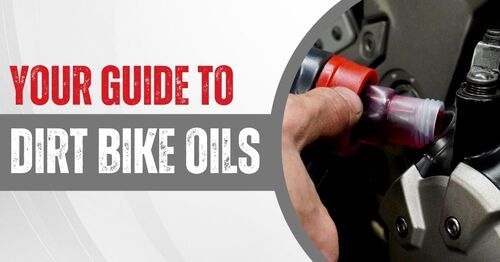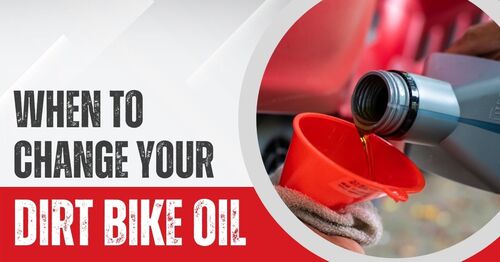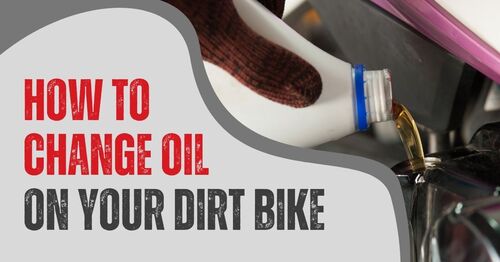Your Guide to Dirt Bike Oils

Oil is like the blood of a dirt bike engine, passing through the vital parts and keeping them lubricated. Good clean oil will keep your engine pumping, without oil, your bike (and your wallet) will unfortunately suffer much pain.
In this article, we’ll talk about the 4 types of oil you’ll need for your dirt bike:
- Engine oil
- Gear oil
- Air filter oil
- Fork oil
Which oils should you use for your dirt bike and for which parts?
Engine Oil
2-Stroke
For a 2-stroke dirt bike, the engine oil is used to lubricate the top-end of your dirt bike, covering the piston, bearings, and rings. Many modern 2-strokes don’t have an oil reservoir, so you’ll have to mix the oil with the fuel to make sure that the engine stays properly lubricated.
The oil and fuel should be mixed at a specific ratio, which you’ll find in your operator’s manual. You absolutely have to get the ratio right. Too much oil can lead to poor performance, clouds of smoke, a fouled spark plug or it may make the bike difficult to start. Too much fuel can cause overheating and can permanently damage the parts because of insufficient lubrication.
Synthetic oil requires less oil per litre than a cheap mineral oil. It runs cleaner and can actually work out better value overall. A full synthetic oil also lubricates your engine better than a mineral oil. Most 2 strokes will run better on synthetic oils but if you have an old vintage bike they may require a mineral oil. Check your owners manual to be sure.
As for the bottom-end of your dirt bike, that requires a different type of oil called gearbox oil or transmission oil. More on that below.
4-Stroke
Oils for 4-stroke dirt bikes are not mixed with the fuel. They work the same way, providing lubrication for the moving parts. For most 4-strokes, you only need 1 motor oil to lubricate everything, from top-end to bottom.
Four-stroke oils, however, have different weights. You’ll have to check your operator’s manual to make sure you’re buying the correct one. The weight of the oil needed depends on your specific dirt bike engine. Generally, an older 4 stroke may run a heavier weight oil such as a 20w/50. Where a modern model may run a lighter oil such as a 10w/40 or 10w/50.
Gear oil or transmission oil
The gear oil, also known as gearbox oil or transmission oil, is used to lubricate the bottom-end of a 2-stroke dirt bike, which includes the transmission, clutch, and bearings. The gear oil not only lubricates but also cools down the clutch and protects the bottom-end from breaking down.
Don’t try to experiment with motor oil or car transmission oil unless you want your clutch to fail you.
What’s the best gear oil? It depends on your dirt bike. And it’s written in your manual. It is usually a synthetic based motorcycle gear oil. Or just ask your local dealer.
Air filter oil
Taking care of your air filter is a huge part of dirt bike maintenance. It is like the lungs of your bike. A clean and correctly oiled air filter protects the engine from pollutants and slows down wear and tear.
Your bike needs a continuous flow of air into the engine for it to keep running. When riding offroad tracks and trails, there’s bound to be dust and dirt in the air, which can make its way into your fuel system and engine. The air filter acts as a protective layer.
A well-oiled air filter will help remove pollutants from the air more effectively than a dry air filter. It can trap dirt and debris and prevent them from going into the engine, which helps keep the engine oil cleaner, lessening the need for oil changes.
If your air filter needs cleaning and you’d like to reuse it, use an air filter cleaner, make sure it dries out completely, and apply a quality air filter oil.
But you can’t use just any oil. Your manual might not contain info on the best air filter oil for your dirt bike, so it’s up to you to look for the best-performing brands. There are many choices, ranging from biodegradable oils to synthetic ones. Many of them come in spray bottles too, making it easier to apply just enough oil where they’re needed. It’s quite easy to put too much and drown the air filter which will end up dripping out of your airbox. An even coating inside and out of the filter is all you need.
Fork oil
If you’re an experienced dirt bike rider, then you probably know about fork oils. Offroad rides and races require more frequent fork oil changes. For some, however, this is the oil they know least about. But that’s understandable.
The forks are basically springs and tubes with oil inside. Like other types of oil, prolonged use reduces the efficiency of the fork oil. And when you’re riding tracks, you subject the forks to heat, impacts, and contamination. If you inspect used fork oil, you might find metal shavings from worn internals and dirt that got through the fork seal. Those metal shavings can further damage the springs and tubes as they move around in the oil so it needs changing periodically. Leaking fork seals can fast track the need to do a fork seal and oil rebuild.
In summary, it sounds obvious, but when buying (and using) these different oils, it’s important not to interchange them as they’re made specifically for the parts they’re supposed to lubricate. As they say, “oils ain't oils”.
Are you getting into the habit of keeping your dirt bike well-maintained? You might like to start with our previous article, Dirt Bike Maintenance: 7 Things Every Dirt Bike Rider Should Do Routinely.


(1).jpg)



